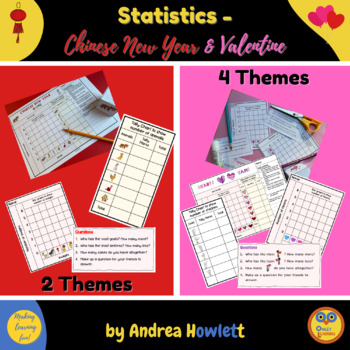Mathematics - Early Statistics for Chinese New Year & Valentine
Owlet Learning
176 Followers
Grade Levels
PreK - 1st, Homeschool
Subjects
Resource Type
Standards
CCSSK.MD.A.2
CCSSK.MD.B.3
CCSS1.MD.C.4
CCSS2.MD.D.10
CCSS3.MD.B.3
Formats Included
- PDF
Pages
74 slides (6 themes)
Owlet Learning
176 Followers
Description
What is a bar graph or tally chart? These resources will generate fun for math games and give students opportunities to create data, draw a statistics graph and then answer questions using this information. They are encouraged to make up their own questions for their peers, thereby learning how to interpret a statistics graph and data collection. The cute clipart and competitive element - as this is a 'race to get to the top' - will keep them engaged and motivated to see who will win.
This will help your students by:
- enjoying math/ maths activities and having fun with peers
- learning about bar graphs and tally charts - how to add information and interpret this
- becoming more confident in understanding how simple data works
- generating their own data which makes this more exciting
- cute Chinese New Year and Valentine clipart makes this fun for activities in February
- 6 different themes to choose from
- games can be used for individuals, pairs or small groups
- this can be fun homework so children can share what they have learned with their family
This will help you by:
- easy prep - print, provide simple resources such as glue, scissors and pencils to make die/ dice
- instructions how to make die/ dice and play games included to make this an independent activity
- a fun way to engage students with statistics for you to assess and explain any misconceptions during their game as an adult-led activity
- this can part of a lesson on statistics so a simple exercise for children to do independently as you teach another group
- children are encouraged to make up their own questions which could be part of the plenary of the lesson as you go through some of their questions - this will encourage them to think up more challenging questions and value their work
- fun homework to share with parents - just print off the dice and games you wish them to work on
- a great addition to use with other activities for Chinese New Year or Valentine
- you can alter the length of the activities by setting a time limit and see who has got furthest on their bar graph or set the number of tally marks higher or lower than the suggested 10
- great for homeschool/ home education
- leave these resources in a central math/ maths area for children to access during free choosing time such as wet playtime early finishers
- color/ colour (6 themes) and black and white (1 theme) for more printing options
- dyslexic font to help students who will benefit from this plus less clipart on some of these pages which is less distracting
- this resource can be printed onto letter size and A4 size paper and uses both U.S. and U.K. spellings
I hope your students enjoy this and become more confident with statistics
Total Pages
74 slides (6 themes)
Answer Key
N/A
Teaching Duration
N/A
Report this resource to TPT
Reported resources will be reviewed by our team. Report this resource to let us know if this resource violates TPT’s content guidelines.
Standards
to see state-specific standards (only available in the US).
CCSSK.MD.A.2
Directly compare two objects with a measurable attribute in common, to see which object has “more of”/“less of” the attribute, and describe the difference. For example, directly compare the heights of two children and describe one child as taller/shorter.
CCSSK.MD.B.3
Classify objects into given categories; count the numbers of objects in each category and sort the categories by count.
CCSS1.MD.C.4
Organize, represent, and interpret data with up to three categories; ask and answer questions about the total number of data points, how many in each category, and how many more or less are in one category than in another.
CCSS2.MD.D.10
Draw a picture graph and a bar graph (with single-unit scale) to represent a data set with up to four categories. Solve simple put-together, take-apart, and compare problems using information presented in a bar graph.
CCSS3.MD.B.3
Draw a scaled picture graph and a scaled bar graph to represent a data set with several categories. Solve one- and two-step “how many more” and “how many less” problems using information presented in scaled bar graphs. For example, draw a bar graph in which each square in the bar graph might represent 5 pets.





